Our team is highly trained and experienced in servicing and producing all types of steel supplies. Need help or have a question?
sales@abrasionresistantpipe.com
Tel.: +8621-3378-0199
Our team is highly trained and experienced in servicing and producing all types of steel supplies. Need help or have a question?
sales@abrasionresistantpipe.com
Tel.: +8621-3378-0199

LSAW (Longitudinal double submerge arc welding) carbon steel pipe is a type of SAW pipe made of steel plates that were hot rolled by JCOE or UOE forming technology.
LSAW (Longitudinal double submerge arc welding) carbon steel pipe is a type of SAW pipe made of steel plates that were hot rolled by JCOE or UOE forming technology.
LSAW (Longitudinally Submerged Arc Welded Steel pipes) in leaflets plate as raw material, the steel plate in the mold or molding machine pressure (volume) into using double-sided submerged arc welding and flaring from production.
Features:
Standard
| Standard | Specification |
| ASTM A53 | Standard Specification for Pipe, Steel, Black and Hot-Dipped, Zinc-Coated, Welded and Seamless |
| API 5L | Specification for Line Pipe(Two levels PSL 1 and PSL 2 of seamless and welded steel pipes for use in pipeline transportation systems in the petroleum and natural gas industries.) |
| A252 | Standard Specification for Welded and Seamless Steel Pipe Piles |
| A500 | Specification for Cold-Formed Welded and Seamless Carbon Steel Structural Tubing in Rounds and Shapes |
| A139 | Standard Specification for Electric-Fusion (Arc)-Welded Steel Pipe (NPS 4 and Over) |
| A672 | Specification for Electric-Fusion-Welded Steel Pipe for High-Pressure Service at Moderate Temperatures |
| A691 | Specification for Carbon and Alloy Steel Pipe, Electric-Fusion-Welded for High-Pressure Service at High Temperatures |
Tolerance of Outside Diameter and Wall Thickness
| Types | Standard | |||||
|---|---|---|---|---|---|---|
| SY/T5040-2000 | SY/T5037-2000 | SY/T9711.1-1977 | ASTM A252 | AWWA C200-97 | API 5L PSL1 | |
| Tube end OD deviation | ±0.5%D | ±0.5%D | -0.79mm-+2.38mm | <±0.1%T | <±0.1%T | ±1.6mm |
| Wall thickness | ±10.0%T | D<508mm, ±12.5%T | -8%T-+19.5%T | <-12.5%T | -8%T-+19.5%T | 5.0mm<t<15.0mm, ±0.11=”” |
| D>508mm, ±10.0%T | T≥15.0mm, ±1.5mm | |||||
Chemical Composition and Mechanical Properties
| Standard | Grade | Chemical Composition(max)% | Mechanical Properties(min) | |||||
|---|---|---|---|---|---|---|---|---|
| C | Mn | Si | S | P | Yield Strength(Mpa) | Tensile Strength(Mpa) | ||
| GB/T700-2006 | A | 0.22 | 1.4 | 0.35 | 0.05 | 0.045 | 235 | 370 |
| B | 0.2 | 1.4 | 0.35 | 0.045 | 0.045 | 235 | 370 | |
| C | 0.17 | 1.4 | 0.35 | 0.04 | 0.04 | 235 | 370 | |
| D | 0.17 | 1.4 | 0.35 | 0.035 | 0.035 | 235 | 370 | |
| GB/T1591-2009 | A | 0.2 | 1.7 | 0.5 | 0.035 | 0.035 | 345 | 470 |
| B | 0.2 | 1.7 | 0.5 | 0.03 | 0.03 | 345 | 470 | |
| C | 0.2 | 1.7 | 0.5 | 0.03 | 0.03 | 345 | 470 | |
| BS En10025 | S235JR | 0.17 | 1.4 | – | 0.035 | 0.035 | 235 | 360 |
| S275JR | 0.21 | 1.5 | – | 0.035 | 0.035 | 275 | 410 | |
| S355JR | 0.24 | 1.6 | – | 0.035 | 0.035 | 355 | 470 | |
| DIN 17100 | ST37-2 | 0.2 | – | – | 0.05 | 0.05 | 225 | 340 |
| ST44-2 | 0.21 | – | – | 0.05 | 0.05 | 265 | 410 | |
| ST52-3 | 0.2 | 1.6 | 0.55 | 0.04 | 0.04 | 345 | 490 | |
| JIS G3101 | SS400 | – | – | – | 0.05 | 0.05 | 235 | 400 |
| SS490 | – | – | – | 0.05 | 0.05 | 275 | 490 | |
| API 5L PSL1 | A | 0.22 | 0.9 | – | 0.03 | 0.03 | 210 | 335 |
| B | 0.26 | 1.2 | – | 0.03 | 0.03 | 245 | 415 | |
| X42 | 0.26 | 1.3 | – | 0.03 | 0.03 | 290 | 415 | |
| X46 | 0.26 | 1.4 | – | 0.03 | 0.03 | 320 | 435 | |
| X52 | 0.26 | 1.4 | – | 0.03 | 0.03 | 360 | 460 | |
| X56 | 0.26 | 1.1 | – | 0.03 | 0.03 | 390 | 490 | |
| X60 | 0.26 | 1.4 | – | 0.03 | 0.03 | 415 | 520 | |
| X65 | 0.26 | 1.45 | – | 0.03 | 0.03 | 450 | 535 | |
| X70 | 0.26 | 1.65 | – | 0.03 | 0.03 | 585 | 570 | |
Polishing means a processing method by the action of mechanical, chemical or electrochemical, lower the q345b steel pipe surface roughness, to obtain a bright and smooth surface, and surface modification process making use of a flexible polishing tools and polishing abrasive particles or other media on the workpiece.
Q345B steel polishing method often used Polishing means a processing method by the action of mechanical, chemical or electrochemical, lower the q345b steel pipe surface roughness, to obtain a bright and smooth surface, and surface modification process making use of a flexible polishing tools and polishing abrasive particles or other media on the workpiece.
Polishing can not improve the dimensional accuracy or geometrical shape accuracy of q345b steel pipe, but can obtain a smooth surface or specular gloss, sometimes to be used to eliminate gloss. Usually buff as a polishing tool. Buff is generally made with multilayer canvas, leather crafted stacked, on both sides clamped with a metal circular plate, its rim coated abrasive mixture of powder and oil and other uniform.
(1) Mechanical q345b steel polishing surface corrosion resistance. As we know, the mechanical polishing q345b steel corrosion resistance is significantly lower than the electrochemical polishing q345b steel pipe, mainly due to the cold mechanical q345b polishing surface hardened steel deformed layer high corrosion rate, coupled with in the mechanical polishing process, inevitably have abrasive particles embedded in the deformable layer, the corrosion rate of deformation layer increased greatly.
(2) electrochemical q345b steel polishing makes the metal surface hardening layer easy to be dissolved, and can lower the surface activity, what’s more, there is a continuous passivation film formed on the surface, significantly improved the corrosion resistance.
Q345B steel is a Chinese standardized low alloy, medium tensile strength steel made with a hot-rolling process, and is used for a number of manufacturing purposes. It is a steel with less than 0.2 percent of its composition made up of carbon, less than 0.55 percent of its composition made of silicon and several impurities (mostly sulfur, chromium and nickel). This particular grade of steel is a ‘general purpose’ manufacturing steel in construction equipment field, such as Q345B is basic mateiral of making excavator bucket and long boom arms.

1, Yield Strength
A yield strength or yield point is the material property defined as the stress at which a material begins to deform plastically. Prior to the yield point the material will deform elastically and will return to its original shape when the applied stress is removed, Yield strength of Q345B is 345 MegaPascals. Like most steels of its grade, it suffers elongation before it pulls apart, typically at 20-21 percent of its initial length.
2, Tensile strength
The tensile strength of a material is the maximum amount of tensile stress that it can take before failure, for example breaking. Steel tensile strength is expressed in units of force divided by cross sectional area; in the Metric system, this unit is known as the Pascal. One Pascal is a Newton (the force needed to accelerate a one kilogram object to a velocity of one meter per second) per square meter. The tensile strength of Q345B steel is rated at 470 to 660 MegaPascals (where mega is million).
| Thickness (mm) | ||||
|---|---|---|---|---|
| Q345B | ≤ 16 | > 16 ≤ 35 | > 35 ≤ 50 | >50 |
| Yield strength (≥Mpa) | 345 | 325 | 295 | 275 |
| Tensile strength (Mpa) | 470-630 | |||
Steel tensile strength is expressed in units of force divided by cross sectional area; in the Metric system, this unit is known as the Pascal. One Pascal is a Newton (the force needed to accelerate a one kilogram object to a velocity of one meter per second) per square meter. The tensile strength of Q345B steel is rated at 470 to 630 MegaPascals (where mega is million) and a yield strength (where the material starts to thin and pull like taffy) at 345 MegaPascals. Like most steels of its grade, it suffers elongation before it pulls apart, typically at 20-21 percent of its initial length.
| Main chemical elements composition of Q345B | |||||||
|---|---|---|---|---|---|---|---|
| C | Si | Mn | P | S | V | Nb | Ti |
| 0.20 | 0.55 | 1.00-1.60 | 0.040 | 0.040 | 0.02-0.15 | 0.015-0.060 | 0.02-0.20 |
The equivalent steel grade with Q345B are EN 10025-2 S355JR,ASTM A572/A572 A572 Grade 50 and DIN 17100 St52-3.
The major benefit of this grade of steel is its mild temper. It’s easy to form and easy to weld.
And also can be applied as construction pipes on offshore platform, power station, petrochemistry and city construction etc.
LSAW (Longitudinally Submerged Arc Welded Steel pipes) in leaflets plate as raw material, the steel plate in the mold or molding machine pressure (volume) into using double-sided submerged arc welding and flaring from production.
Range of roller pipes:
Note: The specification in the table is available to Q345.
Remarks:non-standard dimensions pipes can be produced to customer specifications.
| Number | Technical parameter |
Unit |
HQW11s-120X3200 |
||
|---|---|---|---|---|---|
| 1 | Material yield limited | Mpa | 245 | 345 | 345 |
| 2 | Wall thickness | mm | 120 | 100 | 110 |
| 3 | Maximum pre-bending thickness | mm | 110 | 90 | 100 |
| 4 | Maximum width of steel plate | mm | 3200 | 3200 | 3200 |
| 5 | Minimum diameter of fully loaded rolling steel plate | mm | 2500 | 1600 | 1600 |
Range of roller pipes:

LSAW pipe is used to convey low-pressure liquid or high-pressure petroleum or natural gas and can also be used widely in structural supports or foundations.

Base on its advantage of high reliability and safety performance, the LSAW pipe is widely used in various pipelines engineering and construction, even under the most severe condition, and also can be used in engineering of chemical industry, electric power, irrigation, construction and piling etc.

LSAW pipes for oil and gas pipeline
The advantage for the LSAW type is that they could produce more thick wall thickness of pipes, maximum to 120 mm.
Gas pipeline by pipe process can be divided into seamless steel pipe (SMLS), ERW steel pipe SSW steel pipe ,LSAW steel pipe ,HFW steel pipe etc…
Mainly as a field gathering pipe and internal high-pressure natural gas pipeline of small-caliber, long-distance pipelines for oil and gas a small number, the vast majority of long-distance pipeline is the use of high-frequency straight seam welded pipe (ERW), spiral submerged arc welded pipe (SSAW), LSAW steel pipe (LSAW) three.
The following table shows the characteristics of several steel process and quality performance comparison:
Straight seam high frequency welded pipe (ERW steel pipe) by welding and induction welding is divided into different exposure to welding in two forms, using broadband hot-rolled coils as raw materials, pre-curved, continuous molding, welding, heat treatment, sizing, straightening, cutting and other processes, and spiral welded pipe weld compared to the short, high dimensional accuracy, uniform thickness, surface quality, the advantages of higher pressure, but the drawback is that only produce small-caliber thin-walled tube, easy to produce weldsgray leaf spot, not fusion, groove-shaped corrosion defects. At present more extensive application areas of the city gas, crude oil transportation and so on.
Spiral submerged arc welded pipe (SSAW steel pipe) is the strip volume control when the forward direction and forming a molding pipe centerline angle (adjustable), side molding edge welding, the weld into a spiral, the advantage of the same specifications of the strip can beproduction of a variety of diameters of pipe, meet a wider range of raw materials, welds can avoid the main stress, the force is better, the disadvantage is poor geometry,the weld seam length compared to the straight pipe length, easy to produce cracks, pores, slag, welding and other welding defects side, welding stress was tensile stress state.General long-distance gas pipeline design specification spiral submerged arc welded pipe can only be used for Class 3, Class 4 area.
Foreign raw materials will be changed to improve this process steel, so that separate forming and welding, the welding and lean pre-, post-weld cold-expanding, then the quality of welding close to the UOE pipe, currently there is no such process,is the spiralFactory directions for improvement. “Natural Gas” is still used by the traditional spiral process of production, but the tube side of the expander.United States, Japan and Germany in general negative SSAW, that trunk should not use SSAW; Canada and Italy, some use SSAW, Russia, a small amount of use SSAW, and have developed a very strict additional conditions, due to historical reasons, most still use the main trunk domestic SSAW. LSAW pipe (LSAW) is a single plate as raw material, steel in the mold or molding machine pressure (volume) into the tube, using double-sided submerged arc welding method and Expanding from the produce.
In the construction of high-strength, high toughness, high-quality long-distance gas pipeline, most of the required large diameter thick wall steel pipe LSAW pipe.According to API standards, in large oil and gas pipelines, when through the alpine zone, sea, cities and other densely populated areas Class 1, Class 2 areas, LSAW pipe is the only designated suitable tube.By forming different ways can be divided into:
The wide range of product specifications, weld toughness, ductility, good uniformity and dense, with a large diameter, wall thickness, high pressure, low temperature corrosion resistance and other advantages.
| Product Name | Executive Standard | Dimension (mm) | Steel Code / Steel Grade |
|---|---|---|---|
| Electric-Resistance-Welded Steel Pipes | ASTM A135 | 42.2-114.3 x 2.11-2.63 | A |
| Electric-Resistance-Welded Carbon Steel and Carbon-Manganese Steel Boiler and Superheater Tubes | ASTM A178 | 42.2-114.3 x 2.11-2.63 | A, C,D |
| ERW and Hot-dip Galvanized Steel Pipes | ASTM A53 | 21.3-273 x 2.11-12.7 | A, B |
| Pipes for Piling Usage | ASTM A252 | 219.1-508 x 3.6-12.7 | Gr2, Gr3 |
| Tubes for General Structural Purpose | ASTM A500 | 21.3-273 x 2.11-12.7 | Carbon Steel |
| Square Pipes for General Structural Purpose | ASTM A500 | 25 x 25-160 x 160 x 1.2-8.0 | Carbon Steel |
| Mechanical tubing | ASTM A513 | 21.3-273 x 2.11-12.7 | carbon and alloy steel |
| Screwed and Socketed Steel Tubes | BS 1387 | 21.4-113.9 x 2-3.6 | Carbon Steel |
| Scaffolding Pipes | EN 39 | 48.3 x 3.2-4 | Carbon Steel |
| Carbon Steel Tubes for General Structure Purpose | JIS G3444 | 21.7-216.3 x 2.0-6.0 | Carbon Steel |
| Carbon Steel Tubes for Machine Structure Purpose | JIS G3445 | 15-76 x 0.7-3.0 | STKM11A, STKM13A |
| Carbon Steel Pipes for Ordinary Piping | JIS G3452 | 21.9-216.3 x 2.8-5.8 | Carbon Steel |
| Carbon Steel Pipes for Pressure Service | JIS G3454 | 21.7-216.3 x 2.8-7.1 | Carbon Steel |
| Carbon Steel Rigid Steel Conduits | JIS G8305 | 21-113.4 x 1.2-3.5 | G16-G104, C19-C75, E19-E75 |
| Carbon Steel Rectangular Pipes for General Structure | JIS G3466 | 16 x 16-150 x 150 x 0.7-6 | Carbon Steel |
Pipeline coating is the most consistent and successful solution for protecting ERW pipes from corrosion, from moisture, other harmful chemicals.
Anti-corrosion steel pipe is processed through the preservation process, which can effectively prevent or slow down the process in the transport and use of chemical or electrochemical corrosion reaction of steel pipe.
Therefore pipe anti-corrosion layer is an important barrier to prevent soil erosion. A well-known foreign scholar put forward” 3PE france protective layer”, so far, anti-corrosion methods is widely used.
Coated pipes offer high resistance to corrosion on pipes and provide many benefits such as:
1. Increased Flow Capacity – A coating on pipes helps provide a smoother surface thus improving gas and liquid flow within pipes.
2. Reduced Cost – The pipeline coating increases the pipes durability so they can be deployed with minimum maintenance cost even in the harshest environments.
3. Lower energy usage – Various studies have shown that pipelines that are internally coated use less energy for pumping and compression of products through pipes. This helps in increased saving over time.
4. Clean delivery of products – The inhibitors used for the protection products can also be minimized by the use of coated pipes for delivery of products.
Thus, coating of pipelines can help you in reducing your maintenance cost and at the same time providing a corrosion free reliable protection.
The basic principles of urban gas pipeline coating selection:
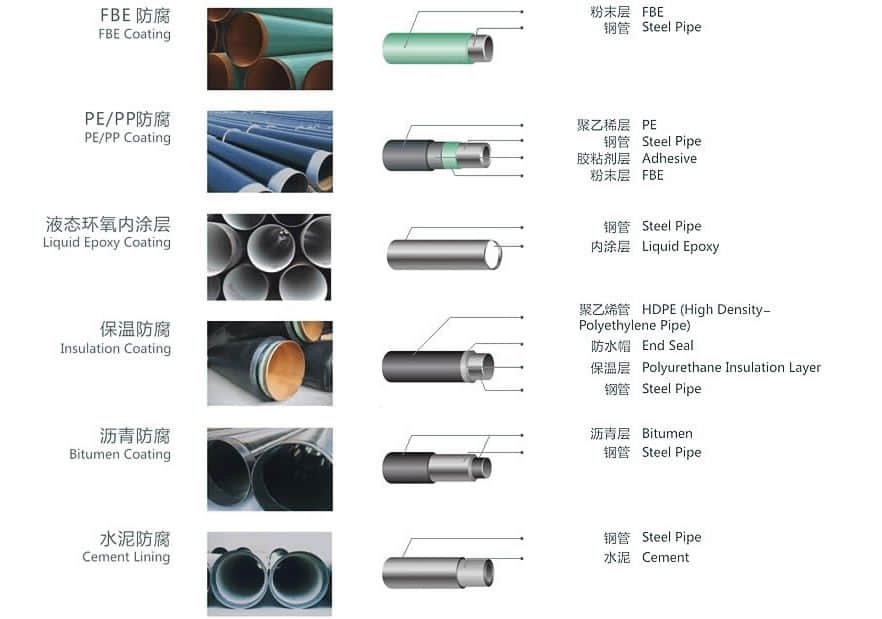
2.1.External Coating
2.1.1 External Epoxy Coating
2.1.2 Polyethylene Coating
2.1.3 Polypropylene Coating
2.1.4 Polyurethane Coating
2.1.5 Polyolefin Coating
2.1.6 Tape Coating
2.1.7 Bitumen Coating
2.1.8 Coal-Tar Enamel Coating
2.1.9 Concrete Weighted Coating
5:External concrete coating.
2.1.10 Marine Coating
2.1.11 Other specification
2.2. Lining
2.2.1 Epoxy Lining
2.2.2 Bitumen Lining
2.2.3 Cement Mortar Lining
2.2.4 Shop Cement Lined Piping
Pipe Coating Products
Three Layer Polyethylene (3LPE)
To improve anticorrosion performance and adhesion, an additional layer of epoxy primer is sprayed onto pipe surfaces prior to the adhesive layer and Polyethylene top layer application. Three Layer Polyethylene is suitable for service temperatures from 60°C to 80°C (85°C peaks). Typical coating thickness is from 1-2 mm to 3-5 mm.
Three Layer Polypropylene (3LPP)
If a wider service temperature range and high stiffness is required, adhesive and top layers, applied over primer layer, are based on polypropylene instead of polyethylene. Three Layer Polypropylene is suitable for service temperatures up to 135 °C (140°C peaks). Typical coating thickness is from 1-2 mm to 3-5 mm.
Three Layer Polypropylene and Polyethylene
Three Layer applications involve a thermoplastic coating applied to steel pipelines as a form of anticorrosion protection. This mechanical resistance is appropriate when the risk of particularly severe coating damages exist. The Three Layer process involved several steps. First, the pipe surface is blast cleaned to remove any external residue from the mill or storage. It is then heated and sprayed with a Fusion Bond Epoxy (FBE) primer followed by the application of an adhesive copolymer and polyolefin polymers that are wrap extruded, one over the other.
Field applied products
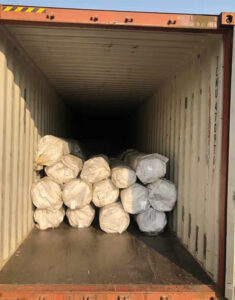
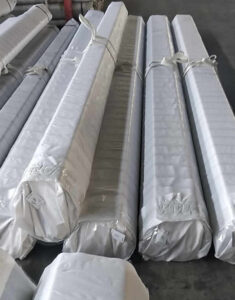
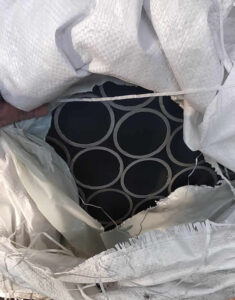
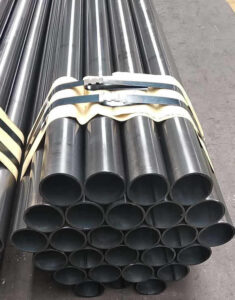
Advantage of ERW pipe
The alloy content of the coil is often lower than similar grades of steel plate, improving the weldability of the spiral welded pipe. Due to the rolling direction of spiral welded pipe coil is not perpendicular to the pipe axis direction, the crack resistance of the spiral welded pipe materials.
Need to inquire about our products? Fill out the form below and our staff will be in touch!
Q: How long is your delivery time?
A: The delivery time of customized products is generally 25 35 days, and non customized products are generally shipped within 24 hours after payment.
Q: Do you provide samples? Is it free?
A: If the value of the sample is low, we will provide it for free, but the freight needs to be paid by the customer. But for some high value samples, we need to charge a fee.
Q: What are your payment terms?
A: T/T 30% as the deposit,The balance payment is paid in full before shipment
Q: What is the packaging and transportation form?
A: Non steaming wooden box and iron frame packaging. Special packaging is available according to customer needs. The transportation is mainly by sea.
Q: What is your minimum order quantity?
A: There is no minimum order quantity requirement. Customized products are tailor made according to the drawings provided by the customer.